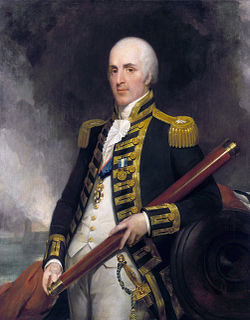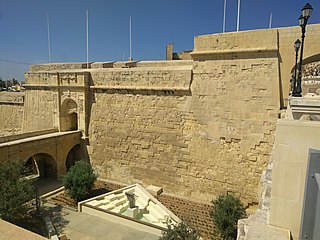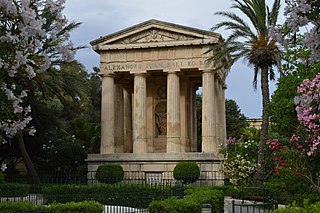
Valletta is the administrative unit and capital of Malta. Located on the main island, between Marsamxett Harbour to the west and the Grand Harbour to the east, its population within administrative limits in 2014 was 6,444. According to the data from 2020 by Eurostat, the Functional Urban Area and metropolitan region covered the whole island and has a population of 480,134. Valletta is the southernmost capital of Europe, and at just 0.61 square kilometres (0.24 sq mi), it is the European Union's smallest capital city.

Sir Alexander John Ball, 1st Baronet was a Rear-Admiral and Civil Commissioner of Malta. He was born in Ebworth Park, Sheepscombe, Gloucestershire. He was the fourth son of Robert and Mary (Dickinson) Ball and the younger brother of Ingram Ball.

Fort Manoel is a star fort on Manoel Island in Gżira, Malta. It was built in the 18th century by the Order of Saint John, during the reign of Grand Master António Manoel de Vilhena, after whom it is named. Fort Manoel is located to the north west of Valletta, and commands Marsamxett Harbour and the anchorage of Sliema Creek. The fort is an example of Baroque architecture, and it was designed with both functionality and aesthetics in mind.

Fort Saint Elmo is a star fort in Valletta, Malta. It stands on the seaward shore of the Sciberras Peninsula that divides Marsamxett Harbour from Grand Harbour, and commands the entrances to both harbours along with Fort Tigné and Fort Ricasoli. It is best known for its role in the Great Siege of Malta of 1565.

The Floriana Lines are a line of fortifications in Floriana, Malta, which surround the fortifications of Valletta and form the capital city's outer defences. Construction of the lines began in 1636 and they were named after the military engineer who designed them, Pietro Paolo Floriani. The Floriana Lines were modified throughout the course of the 17th and 18th centuries, and they saw use during the French blockade of 1798–1800. Today, the fortifications are still largely intact but rather dilapidated and in need of restoration.

The Lower Barakka Gardens is a garden in Valletta, Malta, and it is twinned with the Upper Barrakka Gardens.

The Auberge de Castille is an auberge in Valletta, Malta. The auberge is located at Castile Place, close to Saint James Cavalier, the Malta Stock Exchange, and the Upper Barrakka Gardens. It sits at the highest point of Valletta and overlooks Floriana and the Grand Harbour area.

Lascaris Battery, also known as Fort Lascaris or Lascaris Bastion, is an artillery battery located on the east side of Valletta, Malta. The battery was built by the British in 1854, and it is connected to the earlier St. Peter & Paul Bastion of the Valletta Land Front. In World War II, the Lascaris War Rooms were dug close to the battery, and they served as Britain's secret headquarters for the defence of the island.

Saint John's Cavalier is a 16th-century cavalier in Valletta, Malta, which was built by the Order of St. John. It overlooks St. John's Bastion, a large obtuse-angled bastion forming part of the Valletta Land Front. St. John was one of nine planned cavaliers in the city, although eventually only two were built, the other one being the identical Saint James Cavalier. It was designed by the Italian military engineer Francesco Laparelli, while its construction was overseen by his Maltese assistant Girolamo Cassar.

The fortifications of Malta consist of a number of walled cities, citadels, forts, towers, batteries, redoubts, entrenchments and pillboxes. The fortifications were built over thousands of years, from around 1450 BC to the mid-20th century, and they are a result of the Maltese islands' strategic position and natural harbours, which have made them very desirable for various powers.

The Saluting Battery is an artillery battery in Valletta, Malta. It was constructed in the 16th century by the Order of Saint John, on or near the site of an Ottoman battery from the Great Siege of Malta. The battery forms the lower tier of St. Peter & Paul Bastion of the Valletta Land Front, located below the Upper Barrakka Gardens and overlooking Fort St. Angelo and the rest of the Grand Harbour.

The fortifications of Valletta are a series of defensive walls and other fortifications which surround Valletta, the capital city of Malta. The first fortification to be built was Fort Saint Elmo in 1552, but the fortifications of the city proper began to be built in 1566 when it was founded by Grand Master Jean de Valette. Modifications were made throughout the following centuries, with the last major addition being Fort Lascaris which was completed in 1856. Most of the fortifications remain largely intact today.

The fortifications of Birgu are a series of defensive walls and other fortifications which surround the city of Birgu, Malta. The first fortification to be built was Fort Saint Angelo in the Middle Ages, and the majority of the fortifications were built between the 16th and 18th centuries by the Order of Saint John. Most of the fortifications remain largely intact today.

The fortifications of Senglea are a series of defensive walls and other fortifications which surround the city of Senglea, Malta. The first fortification to be built was Fort Saint Michael in 1552, and the majority of the fortifications were built over the next decade when it was founded by Grand Master Claude de la Sengle. Modifications continued until the 18th century, but large parts of the fortifications were demolished between the 19th and 20th centuries. Today, all that remain of Senglea's fortifications are the seaward bastions and part of the land front.

Ponsonby's Column, also known as Ponsonby's Cenotaph, was a monumental column in Valletta, Malta. It was built in 1838 as a memorial to Major-General Sir Frederick Cavendish Ponsonby, a former Governor of Malta, but it was destroyed by lightning in 1864. Its plinth survived, and is now located near Hastings Gardens.

Victoria Gate is a city gate in Valletta, Malta. It was built by the British in 1885, and was named after Queen Victoria. The gate is the main entrance into the city from the Grand Harbour area, which was once the busiest part of the city. The gate is located between Marina Curtain and St. Barbara Bastion, on the site of the 16th-century Del Monte Gate.

Ġnien is-Sultan, also known as the Giardino della Marina, the Grand Master's Garden or Lascaris Garden, was a garden in Valletta, Malta. It was established in the 17th century by Giovanni Paolo Lascaris, and it included a summer residence for the Grand Master. The garden included several Baroque elements designed by Francesco Buonamici.

The Monument to Sir Alexander Ball is a neoclassical monument in the Lower Barrakka Gardens in Valletta, Malta. It was built in 1810 as a memorial to Sir Alexander Ball, a British admiral who was the first Civil Commissioner of Malta. Attributed to the architect Giorgio Pullicino, the monument is in the form of an ancient Greek temple.
Giorgio Pullicino was a Maltese painter, architect, and professor of drawing and architecture at the University of Malta. He is known for his harbour views painted in a number of media, and he is also considered to be one of the first neoclassical architects in Malta. He produced designs for a number of buildings, but the only structure which is definitely proven to have been designed by him is a monumental obelisk known as the Spencer Monument. However, several other buildings including the Monument to Sir Alexander Ball are widely attributed to him.

The Barrakka Lift is a lift in Valletta, Malta which was constructed in 2012, on the site of a previous lift which had operated from 1905 to 1973 and which was demolished in 1983. It is located inside the ditch of the fortifications of Valletta, and it links Lascaris Wharf to St. Peter and Paul Bastion and the Upper Barrakka Gardens. It therefore allows access from the Grand Harbour to the city.























